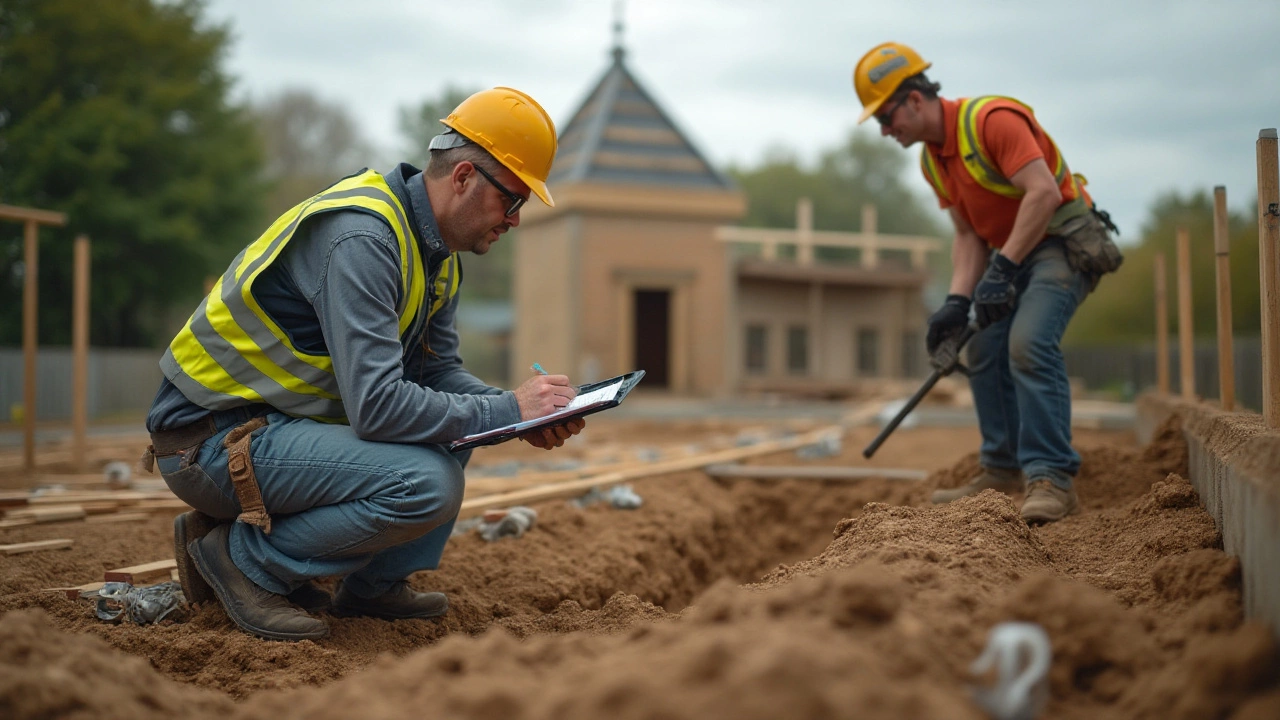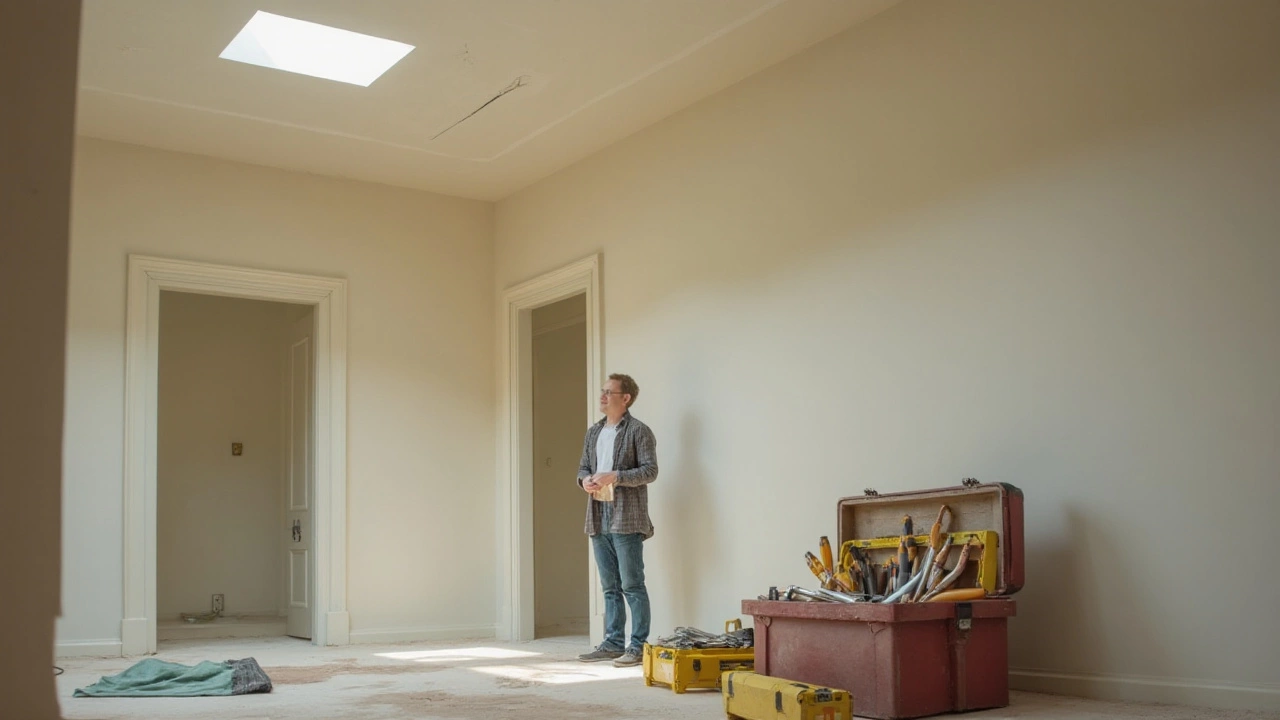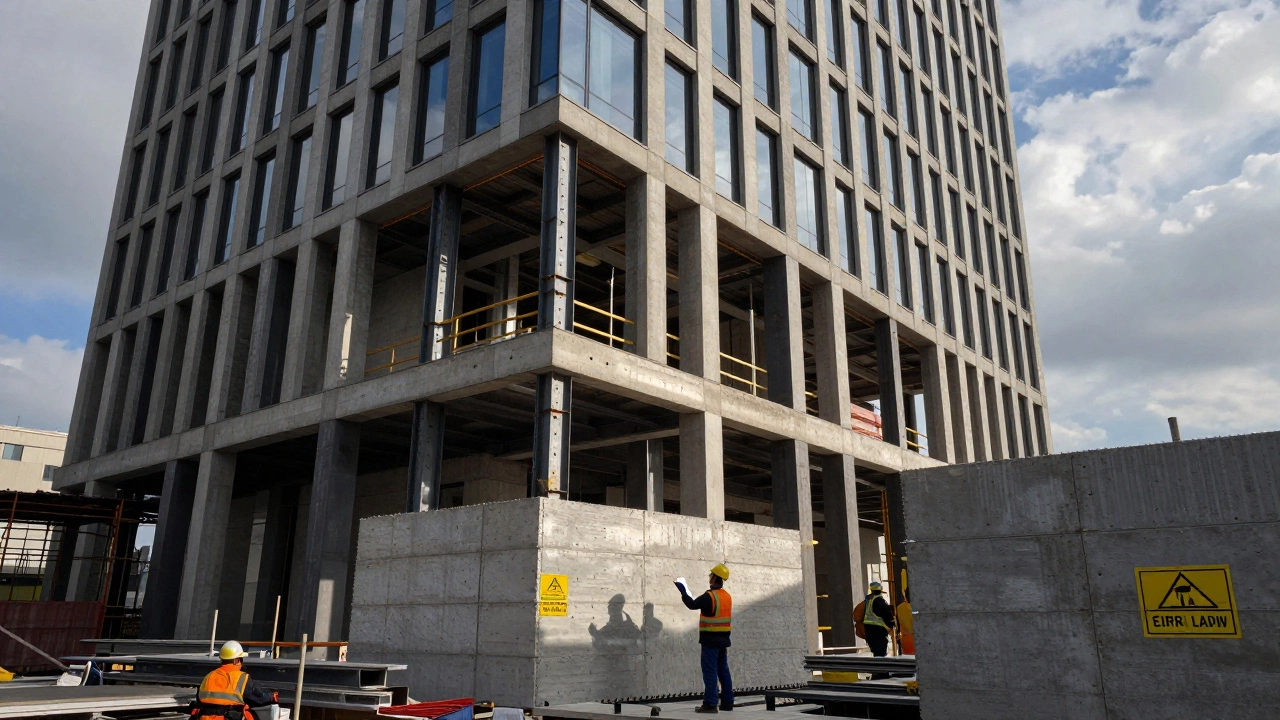Cracking in newly constructed homes can be a source of concern, especially for excited new homeowners eager to settle into their cozy abode. Although common, these imperfections often lead to worries about structural integrity and long-term durability.
To address these concerns, it's essential to start by understanding the fundamental causes of cracking. Many factors, such as settling, material quality, and environmental conditions, play a role in this issue. However, with the proper knowledge and proactive steps, such as focusing on foundation setup and considering the materials you use, you can significantly reduce the occurrence of these unwelcome surprises.
In this guide, you'll find insights and tips to help ensure your new build home stands the test of time, free from unsightly and potentially problematic cracks.
- Understanding the Causes of Cracking
- The Role of Foundation Preparation
- Choosing Quality Materials
- Proper Construction Techniques
- Ongoing Maintenance Tips
Understanding the Causes of Cracking
Cracking in new builds can originate from numerous sources, often intertwining complex elements of nature and construction. The first step towards prevention is a thorough understanding of these factors. A common cause is settling, where newly laid foundations adjust and adapt to the underlying soil. It's this subtle dance between soil and home that can lead to tiny fissures and crevices. Settlement is natural, but unchecked soil movement can wreak havoc on the structure if the foundation wasn't prepared or planned with the right methods.
Hydration also plays a formidable role in this saga. Water might appear benign, yet its interaction with construction materials can be drastic. When a new home's foundation doesn't properly channel rainwater or if gutters are ill-fitted, the build can experience uneven moisture absorption. This differential swelling and shrinking act like a tug-of-war with the integrity of walls and floors. Home foundation plays a significant role in preventing these cracks, which may emerge over the course of many months or even years.
Next, we should consider the materials themselves. As one architect put it, the quality is only as good as the weakest link in the entire construction chain. Concrete, a staple in most builds, is susceptible to cracking due to its properties. When mixed improperly or laid in bad weather conditions, the concrete may not set as intended. This leads to shrinkage cracks that, although sometimes superficial, may indicate deeper issues.
The American Concrete Institute advises, 'The avoidance of cracking quantum lies not just in the curing, but in the careful crafting of the initial mix.'While modern engineering has given us solutions like reinforcements, even the best materials can't entirely forgive improper application.
Climate and environment continue to shape the narrative of new home cracks as well. Homes in colder regions might face frost heaving, where freezing and thawing cycles expand and contract the ground beneath the structure. Conversely, regions with high temperatures can foster the existence of expansive clay soils, notorious for absorbing moisture and expanding significantly. Keeping the balance right ensures stability amid these otherwise relentless natural processes.
The key takeaway in assessing the causes of new build cracks lies not just in identifying these factors but in acknowledging the interplay between them. A minor issue left unresolved can spiral into larger concerns over time. Understanding these hidden threats is your first line of defense in ensuring that your home not only stands tall now but continues to do so for generations.
The Role of Foundation Preparation
The key to a long-lasting and stable new build is a well-prepared foundation. Imagine building a house on a rickety platform—one small movement could spell disaster. Similarly, the strength of a home starts at its base, making it essential to pay keen attention to how the home foundation is laid. Various elements need consideration when preparing a foundation, including soil type, local climate, and drainage systems. Identifying the type of soil is crucial because different soils have different load-bearing capacities. Clay soils, for instance, are notorious for expanding and contracting significantly due to moisture changes, leading to crack prevention challenges. On the other hand, sandy soils drain well but might not offer the same stability as clay or loamy soils, demanding different engineering solutions.
Another factor to consider is the local climate, which can greatly influence foundation planning. Areas with higher rainfall require more robust drainage systems to prevent moisture build-up around the foundation, which can lead to soil swelling and eventual cracking. It is important to properly grade the land, ensuring water flows away from the structure. Proper grading also prevents the accumulation of water near the base of a home, which can weaken the soil and compromise structural integrity over time. Incorporating moisture barriers and keeping the area dry may seem tedious, but these measures are crucial. As Carl Donovan, a well-regarded structural engineer, once said,
"A foundation that’s properly prepared will keep your walls standing tall, for decades to come."
Choosing the right materials for the foundation construction is equally significant. Concrete is a popular choice, known for its durability and strength, but it must be mixed and poured correctly to prevent issues. Reinforcing the concrete with rebar and using additives to improve water resistance can substantially increase its lifespan. Engineers often also consider environmental factors and apply treatments or use specific concrete types suitable for the conditions, which can prevent the cracks that appear in the early years of your new build. With advancements in technology, new materials and techniques have emerged to address a wide range of potential issues, offering builders and homeowners peace of mind.
In foundation preparation, methodical planning and detailed execution are paramount. Hiring a team that understands the intricacies of soil analysis, water management, and construction materials can make an enormous difference. This foundational work not only provides structural safety but also ultimately adds value to your property, avoiding the costly repairs and headaches caused by improper laying of the groundwork. For those serious about their investment, a sturdy and well-prepared foundation is priceless.

Choosing Quality Materials
When it comes to constructing a new home, the importance of selecting high-quality materials cannot be overstated. This is a crucial step in preventing cracks and ensuring the durability and longevity of your dwelling. Quality materials not only contribute to the aesthetic appeal of your home but also to its structural strength and resilience against various environmental factors that could cause damage, such as temperature fluctuations and moisture.
One important aspect of choosing quality materials is understanding the properties of each material and how they interact with one another within the structure. For instance, concrete is a common choice for foundations due to its strength and durability, but it must be cured correctly to prevent shrinkage and cracking. This requires not only the proper mix ratio but also the right environmental conditions, like temperature and humidity, to ensure the concrete sets properly. Additionally, using reinforcement bars, or rebar, can help reinforce concrete, giving it more tensile strength and thus making it less prone to cracking under stress.
"High-quality materials and skilled application are the keystones of any successful construction project," says renowned civil engineer Dr. Linda Harmon. "Compromise on any one of them, and you risk compromising the structural integrity of your build."
Brick and stone, often chosen for their beautiful, timeless appearance, also provide a strong exterior. Yet, even these can fall victim to nature’s whims if not selected properly. The key is to choose bricks and stones that are high-grade and suited to the climate they're expected to endure. This might mean opting for frost-resistant bricks in colder climates or stone materials that can withstand high heat without cracking in warmer areas.
Moreover, timber is widely used in framing due to its natural availability and ease of handling. However, it's essential to select timber that has been appropriately treated to prevent decay, rot, or pest infiltration, all of which can compromise the structure and eventually lead to cracks as materials are weakened. Treated lumber resists these threats and maintains its strength and shape over time, essential for a build that will last.
Here's a quick guide to some key material considerations:
- Concrete: Ensure correct mixing and curing conditions.
- Bricks and Stones: Choose according to climate and finish with a proper sealant.
- Timber: Use treated materials to block out pests and prevent decay.
| Material | Issue | Risk |
|---|---|---|
| Concrete | Improper curing | Increased cracking risk |
| Brick | Non-resistant to frost | Cracking in freeze/thaw cycles |
| Timber | Untreated | Rot and structural weakness |
Combining the right materials with skilled craftsmanship increases the likelihood of avoiding future repairs and renovations. An eye on quality initially pays huge dividends in peace of mind and potentially avoided costs down the road. As construction progresses, remaining engaged and informed about the materials can ensure a seamless and successful project completion, ultimately providing a safe, beautiful, and crack-free new home.
Proper Construction Techniques
Embarking on building a new home can feel exhilarating. Yet, amid the flurry of excitement, laying down the groundwork correctly is one of the most crucial aspects. Proper construction techniques form the backbone of a sound structure, preventing headaches caused by cracks and other premature signs of aging. The starting point for this process involves meticulous planning and adherence to proven methods tailored to your specific environment and site conditions.
A well-prepared blueprint is critical, outlining every nuance of the construction process, which is something both the builder and the homeowner should examine closely. When everyone is on the same page, it significantly reduces errors that can lead to structural issues later on. It's important that both the builder and you have clear, constructive discussions about the details, right from day one. This means understanding the soil type on which your home will sit, which can significantly affect its stability over the years. Soil with high clay content, for example, may expand and contract with moisture, leading to shifting at the base.
Crack prevention can start even before the first brick is laid. Implementing effective water drainage systems ensures that water doesn't pool around the foundation, which could exacerbate cracking as it freezes and expands in cooler climates. Builders often install a network of pipes around the property, engineered to keep unwanted moisture at bay. Also crucial is the quality of materials. Sustainable and robust materials not only extend the lifespan of a building but contribute significantly to its resistance against natural shrinkage and settling.
Adhering to stringent building codes is another key element to consider, offering a structured set of guidelines that must be followed meticulously. These codes are not merely suggestions but are crafted based on years of research and real-world application. They encapsulate everything, from the types of materials suitable for a particular environment to specifics about spacing in framing techniques.
"Durability and safety should never be compromised by cutting corners," says Harold Bennett, a seasoned architect with over three decades in the industry. "Every detail matters when it comes to preventing cracks and ensuring stability."
Moreover, it’s the little tasks that often make a big difference. Regular inspections during the construction phase can identify potential issues before they become tangible problems. Aligning walls correctly, using precise measurements, and ensuring even load distribution all contribute to the overall sturdiness of the structure. Another aspect to explore is the role of technology. Technological advances have led to the development of materials that provide added resistance to cracks, such as flexible concrete. Technologies such as 3D modeling also enable builders to detect weak points in the design before ground is broken.
Lastly, let’s not ignore the human element. Experienced hands, led by a knowledgeable contractor, can leverage past lessons learned to adapt to unforeseen challenges on-site. While high-tech solutions hold their merit, the value of skilled workmanship remains irreplaceable. In conclusion, integrating these construction tips into your building process can help create a home that not only endures over time but stands proud without the mar of unsightly cracks.

Ongoing Maintenance Tips
Proper maintenance is key to preserving the beauty and functionality of your new build, ensuring it stays free from cracks and other structural issues. First, it’s important to conduct regular inspections of your home’s exterior and interior. Look for early signs of wear, such as small hairline cracks that may seem harmless initially but can expand over time if untreated. Begin your examination at the foundation, considering it's the backbone of the entire structure. Check for any shifts or slants, as these can signify foundational issues that may lead to more significant damage down the road. Additionally, realize the importance of managing vegetation around the home. Roots from large trees and shrubs can exert pressure on foundation walls and potentially cause cracks.
Next, consider the impact of climate on the structural integrity of your home. Regions with wide temperature fluctuations or significant rainfall can exacerbate issues with cracking. Employing gutters and downspouts effectively will help control water around your home, preventing the soil around the foundation from becoming overly saturated. This can be especially critical in the spring and fall when the weather tends to be more volatile. Also, homeowners should ensure they have a good grading plan, which directs water away from the house foundation, reducing the potential for water-related damage. Specialists suggest a slope of at least 2% away from foundation walls.
Routine maintenance of seals and caulking is another essential task. Windows, doors, and joints in rough openings are common locations for leaks, especially during inclement weather. Check these areas to ensure they remain solid and watertight. Keeping close attention on the attic, walls, and basement can also help avoid condensation problems that might harm the infrastructure of the home. Routine checks can prevent moisture build-up that often leads to mold or mildew, creating a healthier living environment inside your house.
If you find any issues during your inspection, it's worth consulting with a professional. They can offer tailored solutions to prevent any minor issues from becoming major headaches. Having a maintenance checklist can provide peace of mind, ensuring that no aspect of your new build home is overlooked. Regularly scheduled inspections might seem cumbersome, but they are a practical investment in extending the lifespan of your home. As John Winkler, a leading home construction expert, noted,
"The best time to fix a crack is before it happens."
Lastly, keeping abreast of technological advancements in home maintenance can make a big difference. Modern sensors and smart home technology offer innovations that homeowners from the past couldn’t access. These tools help monitor the home environment, providing alerts if there are changes in the air quality or temperature that could lead to structural damage. Embracing these innovations could be highly beneficial. Remember, preserving a new build isn't just about maintaining aesthetics. It’s about ensuring you have a safe, comfortable, and intimately personalized space to enjoy for many years.




